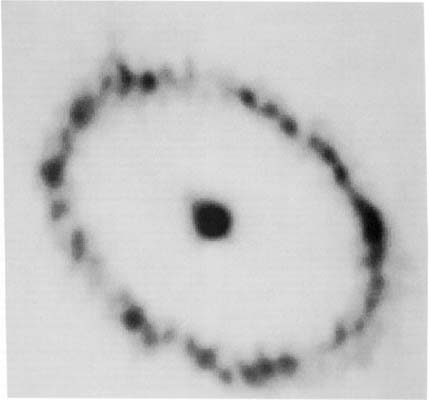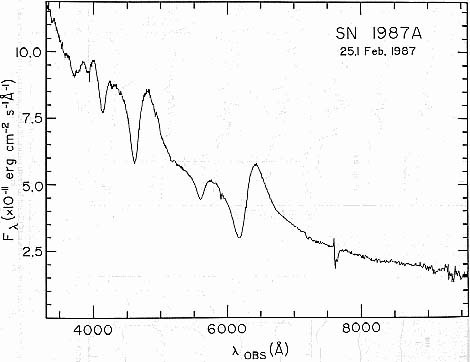
(Note: In order to print this assignment properly, adjust your browser so that
it is about the same width as the above line. Also, several people have
had difficulty printing out the assignment, this is in part due to Netscape
browsers' poor handling of frames! I strongly
recommend that you check the homework you print against the web page to make
sure everything printed!
One of the very first objects observed with the newly launched Hubble Space Telescope was SN 1987A. At the position where the massive blue star Sk -69 202 once was, we now see the remains of the exploded star surrounded by a ring. The angular diameter of this ring is so small that it was not observable from the ground where the atmosphere blurs the image. This ring was one of the most exciting discoveries made with the Hubble Space Telescope. A very important paper used the image of the ring, combined with the strength of special emission lines, to determine the diameter and distance to the ring and SN 1987A. For this assignment, you will take their data and calculate the numbers for yourself.
The ring does not look circular to us because it is tilted at an angle toward our line of sight. This angle is called the inclination angle and is labeled i. A quick review of some trigonometry may be necessary here:

No matter how the ring is tilted, the long axis we see (the major axis, or a) will always be the same length, but as we tilt the ring further and further the minor axis, or b, becomes smaller and smaller. The manner in which the ring around SN 1987A is tilted is such that the top (upper right corner of photo in Figure 1) is closer to us than the bottom.
When the supernova went off, it released a bright flash of visible and ionizing
UV and x-ray radiation. After about 3 months, the x-rays and UV radiation
reached the ring of gas causing the ionized atoms in the ring to emit light.
While the radiation from the supernova illuminated the entire ring
simultaneously (because the supernova is at the center of the ring and the
radiation emits in all directions at the same speed), the entire ring did not
"light up" simultaneously from our point of view (as you saw in
the video in class). The light from the top of the ring, which is tilted toward
us, did not have as far to travel as that from the bottom of the ring, which is
tilted away from us. The interval between the time when we saw the light from
the top of the ring and the time when the entire ring (including the bottom part
of the ring) was illuminated represents the light travel time between the
near side of the ring and the far side of the ring. In our trigonometric diagram
above, this distance is represented as Lt. This represents the
difference in light travel time, Lt = c(tmax-
to), where c is the speed of light.
Now that you understand the geometry of the ring and have reviewed some trigonometric relationships, you can determine important information about the ring.
PRINT THIS OUT OR USE A SEPARATE SHEET OF PAPER TO SHOW YOUR WORK! YOU MUST SHOW YOUR WORK WHERE APPROPRIATE TO GET FULL CREDIT
Questions:
1) At sometime after the supernova explosion, we
began to see the ring emission. Call this time to. At a later
time, tmax, the entire ring was emitting light. At this
moment the ring is its brightest and we see that the entire ring is fully lit.
The total light now begins to fade because the gas in the ring is slowly
cooling. Fig 2 is a graph showing the strength of one of these lines plotted
against the number of days since the supernova explosion. From that diagram,
estimate the time, to, when the light was first seen from the
ring (to is greater than 0 days) and the time, tmax
when the light was at its maximum. Estimate your error. In other words how
precisely are you able to determine these values in days. (For instance, if it
looks like to=250 days, but it could be anywhere between 225 or 275,
your error would be +/- 25 days.)
to =__________+/-(error)____________(days) tmax=__________+/-(error)____________(days)

2) The difference, tmax- to, is the light travel time from the far edge of the ring to the near edge. This time can be converted to a distance by multiplying by the speed of light , c = 3 x 105 km/s. (Remember, there are 86,400 seconds in a day!).
How many km is this distance? Lt=_____________
3) Refer back to our trigonometric diagram, Figure 1. Note that the distance you just determined is not the diameter of the ring, a, but is actually the distance marked as L, the length along our line of sight. Now you know Lt and that Q = 43o. You can now solve for a using the trigonometric relationship a=L/sinQ from the introduction.
The major axis, a, of the ring in km
is______________.
How many parsecs is this? (1pc = 3.1 x 1013
km)_________________
4) Now we can calculate the distance of SN 1987A. In astronomy, where typical objects are at great distances, there is a very important and simple relationship between an object's angular diameter, b, (how large an angle in the sky it subtends) and its actual diameter (a) and distance away from us (d). This is:
If b is expressed in units of radians (remember, there are 180o in p radians) then d will have the same units as a. For instance, if b=.01 radians and a =10 cm, then d = 10cm/.01=1000cm. You know the actual diameter, a, of the ring from part 3. Now you need to determine the angular diameter of the ring in radians. The angular size of the photo in Figure 3 is 1.15 x 10-5 by 1.15 x 10-5 radians. READ CAREFULLY: you must measure what fraction the MAJOR AXIS of the ring is of the photo height and convert this to radians. If you don't understand this procedure read this.

The angular diameter of the ring major axis in radians
The distance to the ring is (d = a/b):_______________
light years (there are 9.46x1012 km
in a light year).
5) The Blast Wave! If you have ever seen those movies from the 1950s showing the buildings that are blown up by atom bombs, you may remember that the radiation from the explosion makes the buildings begin to burn almost immediately. Then a few moments later, the buildings are completely leveled when the powerful blast of supersonic air hits it. The blast wave travels very, very fast, but not nearly as fast as the radiation. SN1987A was very much like an atomic bomb (in the same way that the Earth is like grain of sand): the flash of radiation reached the ring a few months after the explosion; but the blast wave will reach the ring after a greater delay. We are going to estimate that delay and predict when the blast wave will hit the ring.
First we must estimate the speed of the blast wave. We do this by measuring the Doppler shift of absorption lines in the spectrum of the supernova. Below is a spectrum about one day after the explosion. The supernova is expanding so absorption lines due to the atoms in its atmosphere are blue-shifted. If L o is the wavelength of an absorption line in the laboratory and L is observed wavelength, so that DL = L o -L is the wavelength shift, then the expansion velocity, vgas, is given by:
(FYI 2)
where c is the speed of light (300,000 km/s). Look at figure 4, below. The dip just to the right of 6000 angstroms is a blue-shifted absorption line from Hydrogen called Ha (H-alpha). Its "rest" (laboratory measured) wavelength is L o = 6563 angstroms. Find DL by accurately measuring the wavelength, L, of the lowest part of the absorption line and subtracting it from L o. I recommend that you print Figure 4 and use a straight edge, pencil and whatever techniques you can think of to be as precise as possible.

Figure 4
DL
= ____________+/-(error)____________angstroms.
vblast=
__________________km/s
6)
Assuming that the blast wave travels at constant velocity, you can calculate the
time for the blast wave to reach the ring by dividing the radius of the ring
(half its diameter, or a/2) by vgas.
Given that the blast wave began in 1987 when the supernova went off (in OUR time
reference), in what year will we see the blast wave
hit the ring? (1 yr = 3.16x107 seconds)
________________
FYI 1: This equation only works when b
<< 1, as it is in this case. If you become good at estimating
smallish angles you can use this simple relationship to figure out the distances
to objects, like the distance to an airplane flying overhead. Example: Very
approximately, your index finger is .01 radians across when held at arms length.
So if a six foot tall person is just covered up by your index finger turned
sideways at arms length, you know that they are about 6/0.01=600
(the same as 6*100=600) feet away. Pretty neat, huh?
FYI 2:The "D" in the equation is the Greek letter "delta". In math this is traditionally used as an adjective to mean "the change in something". Now when you hear some scientist talking about "delta-lambda" you know he is talking about a red shift or blue shift, and if you hear "delta-v" you know that refers to a change in velocity.)
Question 4 supplement: In question four, you are asked to measure the angular size (in radians) of the ring around SN 1987A. You are given the angular size of the piece of sky of the picture of the ring and you have to estimate the angular size of the ring itself which is smaller than that of the whole picture. This is like being shown a dollar bill and being told it is 15 centimeters long and having to estimate how many centimeters long the picture of George Washington is, but your ruler only has inches on it. Go back to the question.